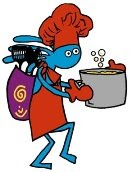Every October, carved pumpkins peer out from porches and doorsteps in
the United States and other parts of the world. Gourd-like orange fruits
inscribed with ghoulish faces and illuminated by candles are a sure
sign of the Halloween season. The practice of decorating
“jack-o’-lanterns”—the name comes from an Irish folktale about a man
named Stingy Jack—originated in Ireland, where large turnips and
potatoes served as an early canvas. Irish immigrants brought the
tradition to America, home of the pumpkin, and it became an integral
part of Halloween festivities.
The Legend of "Stingy Jack"
People have been making jack-o'-lanterns at Halloween
for centuries. The practice originated from an Irish myth about a man
nicknamed "Stingy Jack." According to the story, Stingy Jack invited the
Devil to have a drink with him. True to his name, Stingy Jack didn't
want to pay for his drink, so he convinced the Devil to turn himself
into a coin that Jack could use to buy their drinks. Once the Devil did
so, Jack decided to keep the money and put it into his pocket next to a
silver cross, which prevented the Devil from changing back into his
original form. Jack eventually freed the Devil, under the condition that
he would not bother Jack for one year and that, should Jack die, he
would not claim his soul. The next year, Jack again tricked the Devil
into climbing into a tree to pick a piece of fruit. While he was up in
the tree, Jack carved a sign of the cross into the tree's bark so that
the Devil could not come down until the Devil promised Jack not to
bother him for ten more years.
Soon after, Jack died. As the legend goes, God would not allow such an
unsavory figure into heaven. The Devil, upset by the trick Jack had
played on him and keeping his word not to claim his soul, would not
allow Jack into hell. He sent Jack off into the dark night with only a
burning coal to light his way. Jack put the coal into a carved-out
turnip and has been roaming the Earth with ever since. The Irish began
to refer to this ghostly figure as "Jack of the Lantern," and then,
simply "Jack O'Lantern."
In Ireland and Scotland, people began to make their own versions of
Jack's lanterns by carving scary faces into turnips or potatoes and
placing them into windows or near doors to frighten away Stingy Jack and
other wandering evil spirits. In England, large beets are used.
Immigrants from these countries brought the jack o'lantern tradition
with them when they came to the United States. They soon found that pumpkins, a fruit native to America, make perfect jack-o'-lanterns.
Did You Know.....
In the United States, pumpkins go hand in hand with the fall holidays of
Halloween and Thanksgiving. An orange fruit harvested in October, this
nutritious and versatile plant features flowers, seeds and flesh that
are edible and rich in vitamins. Pumpkin is used to make soups, desserts
and breads, and many Americans include pumpkin pie in their
Thanksgiving meals. Carving pumpkins into jack-o’-lanterns is a popular
Halloween tradition that originated hundreds of years ago in Ireland.
Back then, however, jack-o’-lanterns were made out of turnips or
potatoes; it wasn’t until Irish immigrants arrived in America and
discovered the pumpkin that a new Halloween ritual was born.
Pumpkin Facts
- Pumpkins are a member of the gourd family, which includes cucumbers, honeydew melons, cantaloupe, watermelons and zucchini. These plants are native to Central America and Mexico, but now grow on six continents.
- The largest pumpkin pie ever baked was in 2005 and weighed 2,020 pounds.
- Pumpkins have been grown in North America for five thousand years. They are indigenous to the western hemisphere.
- In 1584, after French explorer Jacques Cartier explored the St. Lawrence region of North America, he reported finding "gros melons." The name was translated into English as "pompions," which has since evolved into the modern "pumpkin."
- Pumpkins are low in calories, fat, and sodium and high in fiber. They are good sources of Vitamin A, Vitamin B, potassium, protein, and iron.
(Source: The History Channel. Retrieved October 3 16, 2012.)
